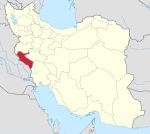Boli Rural District
Persian: دهستان بولی | |
|---|---|
| Coordinates: 33°44′58″N 45°53′23″E / 33.74944°N 45.88972°E[1] | |
| Country | Iran |
| Province | Ilam |
| County | Chavar |
| District | Boli |
| Capital | Chaman-e Seyyed Mohammad |
| Population (2016)[2] | |
| • Total | 1,021 |
| Time zone | UTC+3:30 (IRST) |
Boli Rural District (Persian: دهستان بولی) is in Boli District of Chavar County, Ilam province, Iran. Its capital is the village of Chaman-e Seyyed Mohammad.[3] The previous capital of the rural district was the village of Ganjevan.[4]
Demographics
[edit]Population
[edit]At the time of the 2006 National Census, the rural district's population (as a part of the former Chavar District of Ilam County) was 1,646 in 363 households.[5] There were 1,551 inhabitants in 353 households at the following census of 2011.[6] The 2016 census measured the population of the rural district as 1,021 in 275 households. The most populous of its 28 villages was Ganjevan, with 292 people.[2]
In November 2019, the district was separated from the county in the establishment of Chavar County. The rural district was transferred to the new Boli District.[3]
See also
[edit]References
[edit]- ^ OpenStreetMap contributors (28 March 2024). "Boli Rural District (Chavar County)" (Map). OpenStreetMap (in Persian). Retrieved 28 March 2024.
- ^ a b "Census of the Islamic Republic of Iran, 1395 (2016)". AMAR (in Persian). The Statistical Center of Iran. p. 16. Archived from the original (Excel) on 1 November 2020. Retrieved 19 December 2022.
- ^ a b Jahangiri, Ishaq (8 November 2019). "Letter of approval regarding country divisions in Ilam County, Ilam province". Laws and Regulations Portal of the Islamic Republic of Iran (in Persian). Ministry of Interior, Council of Ministers. Archived from the original on 17 November 2022. Retrieved 4 June 2023.
- ^ Habibi, Hassan (12 December 1371). "Creation of 48 rural districts in several rural areas of the country". Laws and Regulations Portal of the Islamic Republic of Iran (in Persian). Ministry of Interior, Political-Defense Commission of the Government Council. Archived from the original on 28 November 2018. Retrieved 2 January 2024.
- ^ "Census of the Islamic Republic of Iran, 1385 (2006)". AMAR (in Persian). The Statistical Center of Iran. p. 16. Archived from the original (Excel) on 20 September 2011. Retrieved 25 September 2022.
- ^ "Census of the Islamic Republic of Iran, 1390 (2011)". Syracuse University (in Persian). The Statistical Center of Iran. p. 16. Archived from the original (Excel) on 17 January 2023. Retrieved 19 December 2022.



Well, that’s interesting to know that Psilotum nudum are known as whisk ferns. Psilotum nudum is the commoner species of the two. While the P. flaccidum is a rare species and is found in the tropical islands. Both the species are usually epiphytic in habit and grow upon tree ferns. These species may also be terrestrial and grow in humus or in the crevices of the rocks.
View the detailed Guide of Psilotum nudum: Detailed Study Of Psilotum Nudum (Whisk Fern), Classification, Anatomy, Reproduction